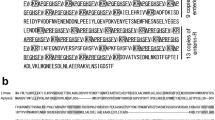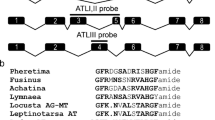Abstract
The Leu-callatostatins are a series of four neuropeptides isolated from nervous tissues of the blowfly Calliphora vomitoria that show C-terminal sequence homology to the allatostatins of cockroaches. The allatostatins have an important role in the reproductive processes of insects as inhibitors of the synthesis and release of juvenile hormone from the corpus allatum. In this study, the distribution of the Leu-callatostatin-immunoreactive neurones and endocrine cells has been mapped in C. vomitoria and, in contrast to the cockroach allatostatins, it has been shown that there is no cytological basis to suggest that the dipteran peptides act as regulators of juvenile hormone. Although occurring in various neurones in the brain and thoracico-abdominal ganglion, there is no evidence of Leu-callatostatin-immunoreactive pathways linking the brain to the corpus allatum, or of immunoreactive terminals in this gland. Three different types of functions for the Leu-callatostatins are suggested by the occurrence of immunoreactive material in cells and by the pathways that have been identified. (1) A role in neurotransmission or neuromodulation appears evident from immunoreactive neurones in the medulla of the optic lobes, and from immunoreactive material in the central body and in descending interneurones in the suboesophageal ganglion that project to the neuropile of the thoracico-abdominal ganglion. (2) Leu-callatostatin neurones directly innervate muscles of the hindgut and the heart. Immunoreactive fibres from neurones of the abdominal ganglion pass by way of the median abdominal nerve to ramify extensively over several areas of the hindgut. Physiological experiments with synthetic peptides show that the Leu-callatostatins are potent inhibitors of peristaltic movements of the ileum. Leu-callatostatin 3 is active at 10-16 to 10-13 M. This form or regulatory control over gut motility appears to be highly specific since the patterns of contraction in other regions are unaffected by these peptides. (3) Evidence that the Leu-callatostatins act as neurohormones comes from the presence of varicosities in axons passing through the corpus cardiacum (but not the corpus allatum) and also from material in extraganglionic neurosecretory cells in the thorax. Fibres from these peripheral neurones are especially prominent over the large nerve bundles supplying the legs. There are also a considerable number of Leu-callatostatin-immunoreactive endocrine cells in a specific region of the midgut. The conclusion from this study is that although conservation of the structure of the allatostatin-type of peptides is evident through a long period of evolution it cannot be assumed that all of their functions have also been conserved. Several different types of functions for the Leu-callatostatins of the blowfly are proposed in this study, but there is no evidence to suggest a role in the regulation of juvenile hormone synthesis and release.
Similar content being viewed by others
References
Bellés X, Piulachs MD (1989) Occurrence of brain allatostatic factors in the cockroach Blattella germanica. Acta Entomol Bohemoslov 86:161–166
Bräunig P (1987) The satellite nervous system—an extensive neurohemal network in the locust head. J Comp Physiol [A] 160:69–77
Cantera R, Nässel DR (1991) Dual peptidergic innervation of the blowfly hindgut: A light- and electron microscopic study of FMRFamide and proctolin immunoreactive fibres. Comp Biochem Physiol [C] 99:517–525
Cook BJ, Wagner RM, Peterson TL (1991) The hindgut muscularis of the stable fly, Stomoxys calcitrans: some of its structural, motile and pharmacological properties. J Insect Physiol 37:635–645
Duve H, Thorpe A (1982) The distribution of pancreatic polypeptide in the nervous system and gut of the blowfly, Calliphora vomitoria (Diptera). Cell Tissue Res 227:67–77
Duve H, Thorpe A (1988) Mapping of enkephalin-related peptides in the nervous system of the blowfly, Calliphora vomitoria, and their co-localization with cholecystokinin (CCK)- and pancreatic polypeptide (PP)-like peptides. Cell Tissue Res 251:399–415
Duve H, Thorpe A (1989) Distribution and functional significance of Met-enkephalin-Arg6-Phe7- and Met-enkephalin-Arg6-Gly7-Leu8-like peptides in the blowfly Calliphora vomitoria. I. Immunocytochemical mapping of neuronal pathways in the brain. Cell Tissue Res 258:147–161
Duve H, Thorpe A (1990) Distribution and functional significance of Met-enkephalin-Arg6-Phe7- and Met-enkephalin-Arg6-Gly7-Leu8-like peptides in the blowfly Calliphora vomitoria. II Immunocytochemical mapping of neuronal pathways in the retrocerebral complex and thoracic ganglion. Cell Tissue Res 259:147–157
Duve H, Thorpe A, Tobe SS (1991a) Immunocytochemical mapping of neuronal pathways from brain to corpora cardiaca/corpora allata in the cockroach Diploptera punctata with antisera against Met-enkephalin-Arg6-Gly7-Leu8. Cell Tissue Res 263:285–291
Duve H, Sewell JC, Scott AG, Thorpe A (1991b) Chromatographic characterisation and biological activity of neuropeptides immunoreactive to antisera against Met5-enkephalin-Arg6-Phe7 (YGGFMRF) extracted from the blowfly Calliphora vomitoria (Diptera). Regul Pept 35:145–159
Duve H, Thorpe A, Yagi KJ, Yu CG, Tobe SS (1992) Factors affecting the biosynthesis and release of juvenile hormone bisepoxide in the adult blowfly Calliphora vomitoria. J Insect Physiol 38:575–585
Duve H, Johnsen AH, Scott AG, Yu CG, Yagi KJ, Tobe SS, Thorpe A (1993) Callatostatins: neuropeptides from the blowfly Calliphora vomitoria with sequence homology to cockroach allatostatins. Proc Natl Acad Sci USA 90:2456–2460
Duve H, Rehfeld JF, East P, Thorpe A (1994) Localisation of sulfakinin neuronal pathways in the blowfly Calliphora vomitoria. Cell Tissue Res 275:177–186
Engelmann F (1957) Die Steuerung der Ovarfunktion bei der ovoviviparen Schabe Leucophaea maderae (Fabr.). J Insect Physiol 1:257–278
Feyereisen R (1985) Regulation of juvenile hormone titre: synthesis. In: Kerkut GA, Gilbert LI (eds) Comprehensive insect physiology, biochemistry and pharmacology, vol 7. Permagon Press, Oxford, pp 391–429
Fifield SM, Finlayson LH (1978) Peripheral neurons and peripheral neurosecretion in the stick insect, Carausius morosus. Proc Soc Lond [Biol] 200:63–85
Finlayson LH, Osborne MP (1968) Peripheral neurosecretory cells in the stick insect (Carausius morosus) and the blowfly (Phormia terrae-novae). J Insect Physiol 14:1793–1801
Fónagy A, Schoofs L, Proost P, Van Damme J, Bueds H, De Loof A (1992) Isolation, primary structure and synthesis of neomyosuppressin, a myoinhibiting neuropeptide from the grey fleshfly Neobellieria bullata. Comp Biochem Physiol [C] 102:239–245
Gupta BL, Berridge MJ (1966) Fine structural organization of the rectum in the blowfly, Calliphora erythrocephala (Meig.) with special reference to connective tissue, tracheae and neurosecretory innervation in the rectal papillae. J Morphol 120:23–82
Holman GM, Cook BJ, Nachman RJ (1986) Isolation, primary structure and synthesis of leucomyosuppressin, an insect neuropeptide that inhibits spontaneous contractions of the cockroach hindgut. Comp Biochem Physiol [C] 85:329–333
Kramer SJ, Toschi A, Miller CA, Kataoka H, Quistad GB, Li JP, Carney RL, Schooley DA (1991) Identification of an allatostatin from the tobacco hornworm Manduca sexta. Proc Natl Acad Sci USA 88:9458–9462
Lanzrein B, Wilhelm R, Buschor J (1981) On the regulation of the corpora allata activity in adult females of the ovoviviparous cockroach Nauphoeta cinerea. In: Pratt GE, Brooks GT (eds) Juvenile hormone biochemistry. Elsevier/North Holland Biomedical Press, Amsterdam, pp 147–160
Miller T, Thomson WW (1968) Ultrastructure of cockroach cardiac innervation. J Insect Physiol 14:1099–1104
Nässel DR (1987) Aspects of the functional and chemical anatomy of the insect brain. In Ali MA (ed) Neurvous Systems in Invertebrates. Plenum Press, New York, London, pp 353–392
Nässel DR (1993) Neuropeptides in the insect brain: a review. Cell Tissue Res 273:1–29
Nagy F (1978) Ultrastructure of a peripheral neurosecretory cell in the proctodaeal nerve of the larva of Oryctes nasicornis L. (Coleoptera: Scarabaeidae). Int J Insect Morphol Embryol 7:325–336
Normann TC (1965) The neurosecretory system of the adult Calliphora erythrocephala. I. The fine structure of the corpus cardiacum with some observations on adjacent organs. Z Zellforsch 67:461–501
Pratt GE, Farnsworth DE, Siegel NR, Fok KF, Feyereisen R (1989) Identification of an allatostatin from adult Diploptera punctata. Biochem Biophys Res Comm 163:1243–1247
Pratt GE, Farnsworth DE, Fok KF, Siegel NR, McCormack AL, Shabanowitz J, Hunt DF, Feyereisen R (1991) Identity of a second type of allatostatin from cockroach brains: An octadecapeptide amide with a tyrosine-rich address sequence. Proc Natl Acad Sci USA 88:2412–2416
Reinecke JP, Cook BJ, Adams TS (1973) Larval hindgut of Manduca sexta (L) (Lepidoptera: Sphingidae). Int J Insect Morphol Embryol 2:277–290
Reinecke JP, Gerst J, O'Gara B, Adams TS (1978) Innervation of hindgut muscle of larval Manduca sexta (L) (Lepidoptera: Sphingidae) by a peripheral multinucleate neurosecretory neuron. Int J Insect Morphol Embryol 7:435–453
Robb S, Packman LC, Evans PD (1989) Isolation, primary structure and bioactivity of schisto FLRF-amide-like neuropeptide from the locust, Schistocerca gregaria. Biochem Biophys Res Commun 160:850–856
Scharrer B (1952) Neurosecretion. XI. The effects of nerve section on the intercerebralis-cardiacum-allatum system of the insect Leucophaea maderae. Biol Bull 102:261–272
Schoofs L, Holman GM, Hayes TK, Nachman RJ, De Loof A (1991) Isolation, identification and synthesis of locustamyoinhibiting peptide (LOM-MIP) a novel biologically active neuropeptide from Locusta migratoria. Regul Pept 31:199–212
Stay B, Tobe SS (1977) Control of juvenile hormone biosynthesis during the reproductive cycle of a viviparous cockroach. I. Activation and inhibition of corpora allata. Gen Comp Endocrinol 33:531–540
Stay B, Chan KK, Woodhead AP (1992 a) Allatostatin-immunoreactive neurons projecting to the corpora allata of adult Diploptera punctata. Cell Tissue Res 279:15–23
Stay B, Woodhead AP, Chan KK (1992 b) Immunocytochemical distribution of allatostatin in the brain and retrocerebral complex of Diploptera punctata. In: Mauchamp B, Couillaud F, Baehr JC (eds) Insect juvenile hormone research. Fundamental and Applied Approaches. INRA, Paris, pp 257–263
Stay B, Joshi S, Tobe SS (1993) Ineffectiveness of an extended methionine enkephalin as a modulator of juvenile hormone synthesis in the cockroach Diploptera punctata. In: Bennettová B, Gelbi I, Soldán T (eds) Advances in regulation of insect reproduction. Inst. Entomology Czech Acad Sci C Budjovice (in press)
Sternberger LA (1974) Immunocytochemistry. Strausfeld NJ (1976) Atlas of an insect brain. Springer, Berlin Heidelberg New York
Thomsen E (1940) Relation between corpus allatum and ovaries in adult flies (Muscidae). Nature 145:28–29
Thomsen E (1969) The neurosecretory system of the adult Calliphora erythrocephala. IV. A histological study of the corpus cardiacum and its connections to the nervous system. Z Zellforsch 94:205–219
Tobe SS, Stay B (1985) Structure and regulation of the corpus allatum. Adv Insect Physiol 18:305–432
Tsang PW, Orchard I (1991) Distribution of FMRFamide-related peptides in the blood-feeding bug, Rhodnius prolixus. J Comp Neurol 311:17–32
Tyrer NM, Turner JD, Altman JS (1984) Identifiable neurons in the locust central nervous system that react with antibodies to serotonin. J Comp Neurol 227:313–330
Wigglesworth VB (1948) Functions of the corpus allatum in Rhodnius prolixus (Hemiptera). J Exp Biol 25:1–14
Wigglesworth VB (1965) The Principles of Insect Physiology. Methuen, London
Woodhead AP, Stay B, Seidel SL, Khan MA, Tobe SS (1989) Primary structure of four allatostatins: Neuropeptide inhibitors of juvenile hormone synthesis. Proc Natl Acad Sci USA 86:5997–6001
Zitnan D, Sehnal F, Bryant PJ (1993) Neurons producing specific neuropeptides in the central nervous system of normal and pupariation-delayed Drosophila. Dev Biol 156:117–135
Author information
Authors and Affiliations
Rights and permissions
About this article
Cite this article
Duve, H., Thorpe, A. Distribution and functional significance of Leu-callatostatins in the blowfly Calliphora vomitoria . Cell Tissue Res 276, 367–379 (1994). https://doi.org/10.1007/BF00306122
Received:
Accepted:
Issue Date:
DOI: https://doi.org/10.1007/BF00306122




